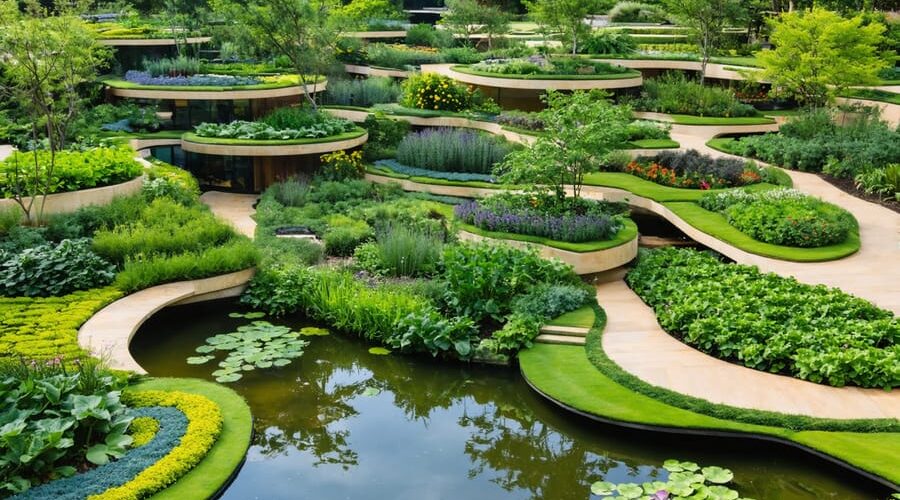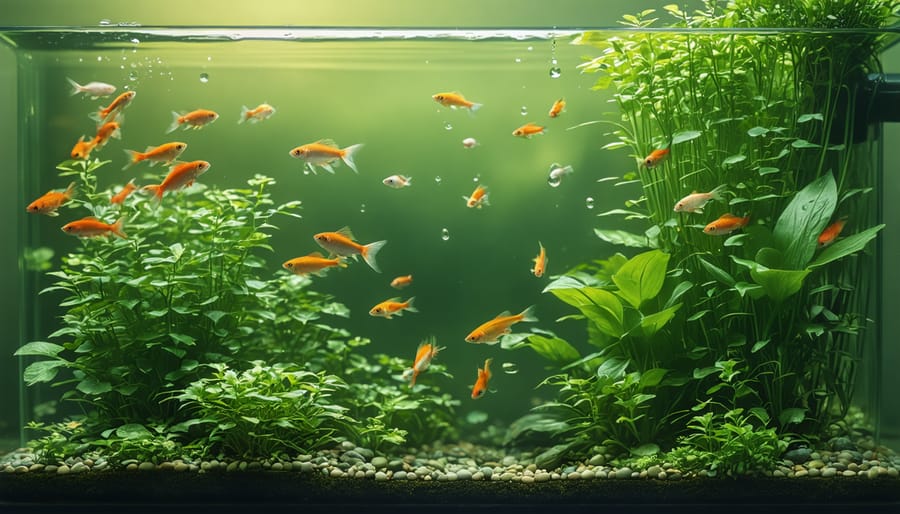
Transform Your Backyard Into a Beautiful Edible Water Garden Paradise
Transform your backyard into a stunning edible oasis by combining ornamental design principles with productive food gardening. Imagine stepping outside to harvest fresh herbs from a cascading stone wall, picking sun-ripened tomatoes nestled among flowering perennials, or gathering fresh berries from an architecturally striking espalier. Edible landscaping breaks the traditional boundaries between decorative gardens and vegetable plots, creating beautiful, functional spaces that nourish both body and soul.
Modern landscape edible gardens prove that growing food doesn’t mean sacrificing beauty. By thoughtfully integrating fruit trees, vegetables, and herbs into existing landscape features, you’ll create a sustainable ecosystem that provides fresh, organic produce while maintaining the aesthetic appeal of a well-designed garden. Whether you have a sprawling yard or a compact urban space, the principles of edible landscaping can help you maximize both beauty and bounty in your outdoor space.
This revolutionary approach to gardening not only enhances your property’s visual appeal but also promotes biodiversity, reduces grocery bills, and provides the incomparable satisfaction of growing your own food. Let’s explore how to create a landscape that’s as productive as it is beautiful.
Planning Your Edible Water Garden Layout

Site Selection and Sun Mapping
Success in creating an edible landscape garden starts with choosing the perfect location and understanding how sunlight moves across your space throughout the day. Begin by observing your garden area for at least a full day, noting how sunlight patterns change. Most edible plants require 6-8 hours of direct sunlight daily, though some leafy greens can thrive in partially shaded areas.
Create a simple sun map by sketching your garden space and marking sunny, partially shaded, and shaded areas. This will help you plan plant placement effectively, just as you would when planning outdoor lighting for water gardens. Consider seasonal changes too – trees that are bare in winter may create shade in summer.
Look for a relatively flat area with good drainage, and ensure it’s easily accessible from your kitchen for convenient harvesting. If possible, choose a location protected from strong winds, which can damage plants and increase water evaporation. Remember, you can always improve soil conditions, but changing light exposure is much more challenging.
Integrating With Existing Landscape Features
Creating an edible landscape that harmonizes with your existing garden features requires thoughtful planning and creative integration. Start by surveying your current landscape elements, such as trees, structures, and pathways, to identify natural connection points for your edible garden. Consider using eco-friendly materials that complement your existing hardscaping while supporting your edible plants.
Work with the natural contours of your land by creating terraced beds that follow existing slopes. This not only looks more natural but also helps with water management and soil retention. If you have mature trees, utilize their partial shade for growing shade-tolerant edibles like leafy greens and herbs.
Incorporate existing pathways into your design by extending them naturally into your edible garden area. Use similar materials or complementary ones to maintain visual continuity. Consider how existing features like pergolas or fences can double as support structures for climbing edibles such as beans or grape vines.
Mix ornamental plants with edibles to create seamless transitions between different garden areas. For example, plant colorful Swiss chard alongside existing flowering perennials, or edge pathways with strawberries and thyme. This blending technique helps your edible garden feel like a natural extension of your landscape rather than a separate vegetable patch.
Remember to maintain sight lines and consider how your edible additions will look throughout all seasons to ensure year-round visual appeal.
Best Edible Plants for Water Gardens
Floating Edibles
Adding floating edibles to your water garden creates a stunning visual effect while providing fresh, nutritious harvests. Water chestnuts, water spinach, and duck potato are excellent choices that naturally thrive on the water’s surface. These plants not only provide tasty additions to your meals but also help maintain water quality by absorbing excess nutrients.
For beginners, water lettuce and watercress are ideal starter plants, requiring minimal maintenance while offering quick returns. Watercress, in particular, grows rapidly and can be harvested year-round in most climates. Its peppery leaves add a delightful kick to salads and sandwiches.
Consider incorporating lotus plants, which offer both beautiful flowers and edible seeds and roots. Their large leaves create natural shade for fish while their striking blooms add dramatic flair to your garden. Arrange floating plants in groups, leaving open water areas for visual balance and easy harvesting.
To maintain your floating edibles, regularly remove yellowing leaves and divide rapidly spreading plants to prevent overcrowding. Most floating edibles thrive in full sun to partial shade and benefit from monthly organic fertilizer applications during the growing season.
Marginal Plants
Marginal plants thrive in the shallow edges of water gardens, creating a seamless transition between water and land while offering delicious harvests. These plants typically grow in water depths of 0-6 inches, making them perfect for the shelves around your pond’s perimeter.
Popular edible marginal plants include watercress, which adds a peppery kick to salads and sandwiches, and Chinese water chestnuts, prized for their crispy texture in stir-fries. Japanese water irises not only produce stunning flowers but also edible petals that can garnish dishes. Water mint spreads enthusiastically along the margins, providing fresh leaves for teas and cocktails.
Consider planting taro for its striking elephant-ear leaves and starchy tubers, a staple in many Asian cuisines. Wild rice grows beautifully in shallow water and offers a nutritious grain harvest. For added variety, try arrow arum, whose young leaves and roots are edible when properly prepared.
When planting marginals, use aquatic baskets filled with heavy garden soil, topped with gravel to prevent soil from floating away. Space plants according to their mature size, and remember that many marginals spread readily, requiring occasional division to maintain control.

Deep Water Plants
In the deeper sections of your water garden, you’ll find some of the most nutritious and fascinating edible plants. Water chestnuts are a popular choice, growing in depths of 6-12 inches and producing crispy, sweet tubers perfect for stir-fries and salads. Watercress thrives in moving water and offers a peppery kick to sandwiches and garnishes while being packed with vitamins A and C.
Consider adding wild rice, which grows beautifully in depths of 6-24 inches and provides both ornamental value with its tall, graceful stalks and nutritious grain. Chinese water spinach, also known as morning glory, flourishes in deeper water and produces tender shoots and leaves that are delicious when stir-fried or steamed.
Lotus is another stunning deep-water plant that serves double duty – its striking flowers create a focal point while its edible tubers, young leaves, and seeds are prized in Asian cuisine. Plant them in depths of 18-30 inches for optimal growth.
For success with deep water plants, use sturdy planting baskets filled with heavy garden soil and topped with gravel to prevent soil from floating away. Position plants at their recommended depths and gradually lower them to their final position over several weeks to help them adjust to deeper water.
Creating a Balanced Ecosystem
Fish and Plant Combinations
When selecting fish for your edible water garden, it’s essential to choose species that work harmoniously with your edible plants. Tilapia is an excellent choice for beginners, as they’re hardy and help control algae while providing a sustainable source of protein. They pair wonderfully with floating plants like water chestnuts and watercress.
For smaller ponds, consider adding goldfish or koi, which not only add vibrant colors to your garden but also help maintain water quality by consuming mosquito larvae and other insects. These fish work particularly well with water lilies and lotus, which provide them with shelter while producing edible pods and roots.
If you’re interested in native species, consider channel catfish, which thrive alongside arrowhead and wild rice. They’re bottom feeders that help keep the pond floor clean while providing delicious meat. For cooler climates, rainbow trout can be an excellent option, complementing plants like watermint and water celery.
Remember to maintain appropriate stocking densities – a general rule of thumb is one inch of fish per gallon of water. Too many fish can stress your system and affect plant growth. Start with a few fish and gradually increase the population as your garden establishes itself. Always ensure your chosen fish species can tolerate your local climate conditions and water temperature ranges.

Natural Filtration Systems
Natural filtration is essential for maintaining a healthy edible water garden ecosystem. By mimicking nature’s own cleaning processes, you can create a self-sustaining environment that keeps your water clear and your plants thriving.
Start by incorporating a mix of submerged, floating, and marginal plants that naturally filter water. Water lilies and lotus provide shade that prevents algae growth, while plants like cattails and rushes remove excess nutrients. Beneficial bacteria that naturally colonize plant roots and rocks help break down organic waste.
Create a dedicated biological filtration zone using gravel beds planted with moisture-loving herbs like watercress and mint. As water flows through this area, beneficial bacteria break down harmful compounds while the plants absorb excess nutrients. This process, known as phytoremediation, helps maintain water quality naturally.
Adding a small waterfall or fountain doesn’t just create peaceful sounds – it also oxygenates the water and supports beneficial microorganisms. Position these features to ensure water movement throughout your garden, preventing stagnant areas where algae might flourish.
Remember to include bottom-feeding fish like koi or goldfish, which help control mosquito larvae and stir up sediment that can then be filtered out. The fish waste also provides natural fertilizer for your edible plants, completing the ecological cycle.
By establishing these natural filtration systems, you’ll spend less time on maintenance and more time enjoying your thriving water garden.
Maintenance and Harvesting Tips
Seasonal Care Schedule
A successful edible landscape requires consistent year-round garden maintenance to ensure optimal growth and harvest. In spring, focus on soil preparation, adding compost and starting your first round of seedlings. Plant warm-season crops like tomatoes and herbs after the last frost, and establish new perennial edibles.
Summer brings the peak growing season, requiring regular harvesting, pruning, and pest monitoring. Water deeply during dry spells, preferably in the early morning. Add mulch to retain moisture and suppress weeds. Keep an eye out for signs of disease or nutrient deficiencies in your plants.
Fall is harvest time for many late-season crops. Begin cleaning up spent plants and prepare beds for winter by adding organic matter. Plant cold-hardy vegetables like kale and garlic for winter harvests. Collect seeds from successful plants for next year’s garden.
Winter is for planning and maintenance. Protect perennial plants with mulch, maintain winter crops under protection if needed, and repair garden structures. Use this quieter time to plan next season’s layout, order seeds, and maintain tools. Remember to keep harvesting winter-hardy vegetables and herbs that continue producing.
Harvesting Methods
Harvesting from your edible landscape garden requires careful timing and proper techniques to ensure the best flavor and continued plant health. For leafy greens like lettuce and herbs, harvest the outer leaves first, allowing the inner leaves to continue growing. This “cut-and-come-again” method extends your harvest season significantly.
When picking fruits and vegetables, use clean, sharp scissors or pruning shears to make clean cuts that prevent damage to the plant. Most vegetables should be harvested in the morning when they’re at their freshest and most flavorful. Tomatoes should be picked when they’re fully colored but still firm, while peas and beans are best harvested when the pods are plump but not overly mature.
Root vegetables like carrots and potatoes can be gently lifted from the soil when their tops begin to die back. Test readiness by carefully exposing the top of one root to check its size. For herbs, harvest just before flowering for the most intense flavor, cutting stems back to about 6 inches to encourage bushier growth.
Remember to harvest regularly – this not only provides fresh produce but also stimulates continued production and prevents plants from becoming overgrown or going to seed prematurely.
Creating and maintaining an edible water garden is truly a rewarding journey that offers multiple layers of satisfaction. As you watch your aquatic edibles flourish and mature, you’ll discover the joy of harvesting fresh, nutritious produce right from your own water feature. The gentle sound of flowing water, combined with the lush greenery and vibrant colors of your edible plants, creates a peaceful sanctuary that appeals to all your senses.
Beyond the obvious benefits of fresh, home-grown food, your edible water garden becomes a fascinating ecosystem that attracts beneficial wildlife and creates a natural balance in your landscape. Dragonflies dance above the water’s surface, while birds visit for a refreshing drink, making your garden a hub of biodiversity.
The satisfaction of sharing your harvest with friends and family adds another dimension to the experience. Whether it’s serving a salad featuring your home-grown watercress or sharing tips with fellow gardeners, your edible water garden becomes a source of pride and connection.
Perhaps most importantly, maintaining an edible water garden helps develop a deeper appreciation for sustainable living and the delicate relationship between water, plants, and our food system. It’s a living reminder that beautiful landscapes can be both ornamental and productive, providing nourishment for both body and soul. As you continue to learn and grow with your garden, you’ll find that the rewards far outweigh the initial effort of setting it up.
